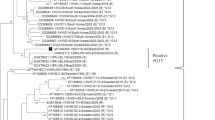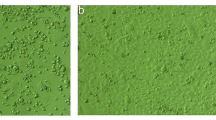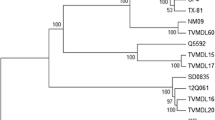Abstract
Bovine rhinitis B virus (BRBV) (genus Aphthovirus, family Picornaviridae) is a significant etiological agent of the bovine respiratory disease complex. Despite global reports on BRBV, genomic data for Japanese strains are not available. In this study, we aimed to obtain genomic information on BRBV in Japan and analyze its genetic characteristics. In nasal swabs from 66 cattle, BRBV was detected in 6 out of 10 symptomatic and 4 out of 56 asymptomatic cattle. Using metagenomic sequencing and Sanger sequencing, the nearly complete genome sequences of two Japanese BRBV strains, IBA/2211/2 and LAV/238002, from symptomatic and asymptomatic cattle, respectively, were determined. These viruses shared significant genetic similarity with known BRBV strains and exhibited unique mutations and recombination events, indicating dynamic evolution, influenced by regional environmental and biological factors. Notably, the leader gene was only approximately 80% and 90% identical in its nucleotide and amino acid sequence, respectively, to all of the BRBV strains with sequences in the GenBank database, indicating significant genetic divergence in the Japanese BRBV leader gene. These findings provide insights into the genetic makeup of Japanese BRBV strains, enriching our understanding of their genetic diversity and evolutionary mechanisms.




Similar content being viewed by others
Data availability
The datasets generated during and/or analyzed during the current study are available from the corresponding author on reasonable request.
References
Zell R, Delwart E, Gorbalenya AE, Hovi T, King AMQ, Knowles NJ, Lindberg AM, Pallansch MA, Palmenberg AC, Reuter G, Simmonds P, Skern T, Stanway G, Yamashita T, Ictv Report Consortium (2017) ICTV virus taxonomy profile: picornaviridae. J Gen Virol 98:2421–2422. https://doi.org/10.1099/jgv.0.000911
Hollister JR, Vagnozzi A, Knowles NJ, Rieder E (2008) Molecular and phylogenetic analyses of bovine rhinovirus type 2 shows it is closely related to foot-and-mouth disease virus. Virology 373:411–425. https://doi.org/10.1016/j.virol.2007.12.019
Reed SE, Tyrrell DA, Betts AO, Watt RG (1971) Studies on a rhinovirus (EC11) derived from a calf. I. Isolation in calf tracheal organ cultures and characterization of the virus. J Comp Pathol 81:33–40. https://doi.org/10.1016/0021-997590052-1
Mitra N, Cernicchiaro N, Torres S, Li F, Hause BM (2016) Metagenomic characterization of the virome associated with bovine respiratory disease in feedlot cattle identified novel viruses and suggests an etiologic role for influenza D virus. J Gen Virol 97:1771–1784. https://doi.org/10.1099/jgv.0.000492
Ng TF, Kondov NO, Deng X, Van Eenennaam A, Neibergs HL, Delwart E (2015) A metagenomics and case-control study to identify viruses associated with bovine respiratory disease. J Virol 89:5340–5349. https://doi.org/10.1128/JVI.00064-15
Zhang M, Hill JE, Fernando C, Alexander TW, Timsit E, van der Meer F, Huang Y (2019) Respiratory viruses identified in western Canadian beef cattle by metagenomic sequencing and their association with bovine respiratory disease. Transbound Emerg Dis 66:1379–1386. https://doi.org/10.1111/tbed.13172
Bhattarai S, Lin CM, Temeeyasen G, Palinski R, Li F, Kaushik RS, Hause BM (2022) Bovine rhinitis B virus is highly prevalent in acute bovine respiratory disease and causes upper respiratory tract infection in calves. J Gen Virol 103:001714. https://doi.org/10.1099/jgv.0.001714
Hause BM, Collin EA, Anderson J, Hesse RA, Anderson G (2015) Bovine rhinitis viruses are common in U.S. cattle with bovine respiratory disease. PLOS One 10:e0121998. https://doi.org/10.1371/journal.pone.0121998
Tosh C, Hemadri D, Sanyal A (2002) Evidence of recombination in the capsid-coding region of type A foot-and-mouth disease virus. J Gen Virol 83:2455–2460. https://doi.org/10.1099/0022-1317-83-10-2455
Rai DK, Lawrence P, Pauszek SJ, Piccone ME, Knowles NJ, Rieder E (2016) Bioinformatics and molecular analysis of the evolutionary relationship between bovine rhinitis A viruses and foot-and-mouth disease virus. Bioinform Biol Insights 4:43–58. https://doi.org/10.4137/BBI.S37223
Zhou Y, Chen X, Tang C, Yue H (2023) Detection and genomic characterization of bovine rhinitis virus in China. Animals 13:312. https://doi.org/10.3390/ani13020312
Kishimoto M, Tsuchiaka S, Rahpaya SS, Hasebe A, Otsu K, Sugimura S, Kobayashi S, Komatsu N, Nagai M, Omatsu T, Naoi Y, Sano K, Okazaki-Terashima S, Oba M, Katayama Y, Sato R, Asai T, Mizutani T (2017) Development of a one-run real-time PCR detection system for pathogens associated with bovine respiratory disease complex. J Vet Med Sci 79:517–523. https://doi.org/10.1292/jvms.16-0489
Thompson JD, Gibson TJ, Plewniak F, Jeanmougin F, Higgins DG (1997) The CLUSTAL_X windows interface: flexible strategies for multiple sequence alignment aided by quality analysis tools. Nucleic Acids Res 25:4876–4882. https://doi.org/10.1093/nar/25.24.4876
Tamura K, Stecher G, Kumar S (2021) MEGA11: molecular evolutionary genetics analysis version 11. Mol Biol Evol 38:3022–3027. https://doi.org/10.1093/molbev/msab120
Felsenstein J (1985) Confidence limits on phylogenies: an approach using the bootstrap. Evolution 39:783–791
Martin DP, Murrell B, Golden M, Khoosal A, Muhire B (2015) RDP4: detection and analysis of recombination patterns in virus genomes. Virus Evol 1:vev003. https://doi.org/10.1093/ve/vev003
Lole KS, Bollinger RC, Paranjape RS, Gadkari D, Kulkarni SS, Novak NG, Ingersoll R, Sheppard HW, Ray SC (1999) Full-length human immunodeficiency virus type 1 genomes from subtype C-infected seroconverters in India, with evidence of intersubtype recombination. J Virol 73:152–160. https://doi.org/10.1128/JVI.73.1.152-160.1999
Holman DB, Timsit E, Alexander TW (2015) The nasopharyngeal microbiota of feedlot cattle. Sci Rep 5:15557. https://doi.org/10.1038/srep1555
Holman DB, Timsit E, Amat S, Abbott DW, Buret AG, Alexander TW (2017) The nasopharyngeal microbiota of beef cattle before and after transport to a feedlot. BMC Microbiol 17:70. https://doi.org/10.1186/s12866-017-0978-6
Ashkani J, Rees DJ (2016) The critical role of VP1 in forming the necessary cavities for receptor-mediated entry of FMDV to the host cell. Sci Rep 6:27140. https://doi.org/10.1038/srep27140
Mason PW, Grubman MJ, Baxt B (2003) Molecular basis of pathogenesis of FMDV. Virus Res 91:9–32. https://doi.org/10.1016/s0168-1702(02)00257-5
Sherry B, Rueckert R (1985) Evidence for at least two dominant neutralization antigens on human rhinovirus 14. J Virol 53:137–143. https://doi.org/10.1128/JVI.53.1.137-143.1985
Sherry B, Mosser AG, Colonno RJ, Rueckert RR (1986) Use of monoclonal antibodies to identify four neutralization immunogens on a common cold picornavirus, human rhinovirus 14. J Virol 57:246–257. https://doi.org/10.1128/JVI.57.1.246-257.1986
King DJ, Freimanis G, Neil C, Shaw A, Tuthill TJ, Laing E, King DP, Lasecka-Dykes L (2022) Establishing an in vitro system to assess how specific antibodies drive the evolution of foot-and-mouth disease virus. Viruses 14:1820. https://doi.org/10.3390/v14081820
Ao D, Guo HC, Sun SQ, Sun DH, Fung TS, Wei YQ, Han SC, Yao XP, Cao SZ, Liu DX, Liu XT (2015) Viroporin activity of the foot-and-mouth disease virus non-structural 2B protein. PLoS One 10:e0125828. https://doi.org/10.1371/journal.pone.0125828
Moffat K, Knox C, Howell G, Clark SJ, Yang H, Belsham GJ, Ryan M, Wileman T (2007) Inhibition of the secretory pathway by foot-and-mouth disease virus 2BC protein is reproduced by coexpression of 2B with 2C, and the site of inhibition is determined by the subcellular location of 2C. J Virol 81:1129–1139. https://doi.org/10.1128/JVI.00393-06
Ambrose RK, Blakebrough-Hall C, Gravel JL, Gonzalez LA, Mahony TJ (2013) Characterisation of the upper respiratory tract virome of feedlot cattle and its association with bovine respiratory disease. Viruses 15:455. https://doi.org/10.3390/v15020455
Yang X, Hu Z, Zhang Q, Fan S, Zhong Y, Guo D, Qin Y, Chen M (2019) SG formation relies on eIF4GI-G3BP interaction which is targeted by picornavirus stress antagonists. Cell Discov 5:1. https://doi.org/10.1038/s41421-018-0068-4
Grubman MJ, Baxt B (2004) Foot-and-mouth disease. Clin Microbiol Rev 17:465–493. https://doi.org/10.1128/cmr.17.2.465-493.2004
Belsham GJ, Brangwyn JK (1990) A region of the 5′ noncoding region of foot-and-mouth disease virus RNA directs efficient internal initiation of protein synthesis within cells: involvement with the role of L protease in translational control. J Virol 64:5389–5395. https://doi.org/10.1128/JVI.64.11.5389-5395.1990
Moral-Lopez P, Alvarez E, Redondo N, Skern T, Carrasco L (2014) L protease from foot and mouth disease virus confers eIF2-independent translation for mRNAs bearing picornavirus IRES. FEBS Lett 588:4053–4059. https://doi.org/10.1016/j.febslet.2014.09.030
Acknowledgments
We gratefully acknowledge the grants received from the Japan Society for the Promotion of Science for this research. We would like to thank Enago for their assistance in improving the English language quality of our manuscript.
Funding
This work was supported by grants-in-aid from the Japan Society for the Promotion of Science (grant numbers 22K20619 and 23K14097).
Author information
Authors and Affiliations
Contributions
Hiroho Ishida: conceptualization, investigation, formal analysis, funding acquisition, writing—original draft. Mikari Nakamura: investigation, validation, visualization. Hironobu Murakami: formal analysis, writing—review & editing. Kei Kazama: resources, investigation. Mami Oba: data curation. Hitoshi Takemae: data curation. Tetsuya Mizutani: methodology, supervision. Yoshinao Ouchi: resources. Junko Kawakami: resources. Satoko Tsuzuku: resources. Makoto Nagai: writing—review & editing, supervision.
Corresponding author
Ethics declarations
Ethical approval
The swab samples that were used in this study were collected for pathological testing of cattle; therefore, no specific approval was needed.
Conflict of interest
The authors have no relevant financial or non-financial interests to disclose.
Additional information
Handling Editor: Pablo Pineyro
Publisher's Note
Springer Nature remains neutral with regard to jurisdictional claims in published maps and institutional affiliations.
Supplementary Information
Below is the link to the electronic supplementary material.
Rights and permissions
Springer Nature or its licensor (e.g. a society or other partner) holds exclusive rights to this article under a publishing agreement with the author(s) or other rightsholder(s); author self-archiving of the accepted manuscript version of this article is solely governed by the terms of such publishing agreement and applicable law.
About this article
Cite this article
Ishida, H., Nakamura, M., Murakami, H. et al. Detection and genetic analysis of bovine rhinitis B virus in Japan. Arch Virol 169, 125 (2024). https://doi.org/10.1007/s00705-024-06046-y
Received:
Accepted:
Published:
DOI: https://doi.org/10.1007/s00705-024-06046-y




